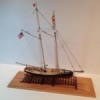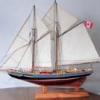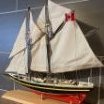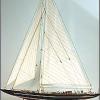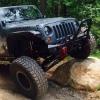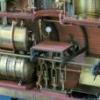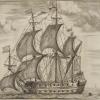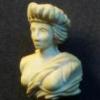-
Posts
815 -
Joined
-
Last visited
Reputation Activity
-
 _SalD_ got a reaction from canoe21 in US Brig Syren by _SalD_ – FINISHED - 3/16" scale
_SalD_ got a reaction from canoe21 in US Brig Syren by _SalD_ – FINISHED - 3/16" scale
It seemed like I worked all weekend on the ship but didn't get much accomplished. First I beveled the bulkheads slightly just shy of the guide lines. Then I glued all the bulkheads to the BF being careful to align each one 90 degrees and vertical to it. I did one at a time and waited three to four hours for the glue to set before gluing the next one in place. One thing I discovered while dry fitting the bulkheads in place was that Jenga blocks suck for lining up the bulkheads (scratch that idea). I used a modified version of Floyd Kershner’s aluminum angles and a drafting triangle. I also attached the bow fillers and filler material to bulkhead ‘P’ prior the gluing it in place. I just thought it might be easier to get the basic shape down before gluing it in place.
Bulkhead 'P' with fillers attached
Finished product
-
 _SalD_ got a reaction from avsjerome2003 in US Brig Syren by _SalD_ – FINISHED - 3/16" scale
_SalD_ got a reaction from avsjerome2003 in US Brig Syren by _SalD_ – FINISHED - 3/16" scale
It seemed like I worked all weekend on the ship but didn't get much accomplished. First I beveled the bulkheads slightly just shy of the guide lines. Then I glued all the bulkheads to the BF being careful to align each one 90 degrees and vertical to it. I did one at a time and waited three to four hours for the glue to set before gluing the next one in place. One thing I discovered while dry fitting the bulkheads in place was that Jenga blocks suck for lining up the bulkheads (scratch that idea). I used a modified version of Floyd Kershner’s aluminum angles and a drafting triangle. I also attached the bow fillers and filler material to bulkhead ‘P’ prior the gluing it in place. I just thought it might be easier to get the basic shape down before gluing it in place.
Bulkhead 'P' with fillers attached
Finished product
-
 _SalD_ reacted to ChrisLinden in Painting Tutorial Ornaments / Cast Metal parts
_SalD_ reacted to ChrisLinden in Painting Tutorial Ornaments / Cast Metal parts
Introduction
My name is Chris van der Linden. I have roughly 15 years experience with painting metal and plastic miniatures. I started the wooden modelship building hobby only recently, about 2 years ago and noticed a lot of people are struggling with how to paint their cast metal ornaments to a satisfying standard. I decided to write down my experience on this topic for everyone to enjoy.
Note: this tutorial focusses on metal colored finish right now. I will add an additional explanation on how to do different colors.
Easy for anyone
One thing I have learned is that painting is not as difficult as it seems. Sometimes people are amazed at the small details, believing they need a 1-haired brush and loupe to pull it off. This is NOT the case. Even with 2 simple steps you can have great looking (repeatable) results.
Disclaimer
Please use this guide and techniques to your own discretion. Always use a tester if you are unsure about the results. Each situation and personal preference is different. I can say however that I have used all of these techniques a lot without problems. I provide these tips for your satisfaction, this is by no means "they best way" to do it...
1. What paints to use?
Painting cast metal parts has its origins in "tin miniatures" painting, the toy soldiers we all remember. A common misconception is that painting on metal requires Humbrol or Oil paints. This is not true anymore.
Brands like Citadel and Vallejo have developed acrylic (water based) paints that have exceptionally good coverage even on un-treated metal parts. This is great because they are much easier to work with. Humbrol is tricky to thin down and mix with other colors, requires turpentine to wash and takes long to dry. Oil paint takes even longer to dry...
Long story short: I always work with water based acrylic paints from Citadel and Vallejo on metal cast parts.
It dries fast, is easy to thin down, mix and work with. Add your wife/girlfriend's blowdrier and you can work even faster
Citadel paints tend to have rather funny names because they are used for fantasy/sci-fi minatures. So a certain red might be "Blood Red" or "Merchrite Red". This is their alternative for having "paint numbers". Both these brands also offer specialist paints such as instant rust, metallic colors, texture paints and weathering powders.
2. Preparation
a. Removing Flash / Mold Lines
As a result of the casting process most models have Flash and Mold lines. These are unwanted and you get a nicer looking part if you take some time to remove these. Flash is a bit of excess material that has run in between mold parts, usually giving a thin sort of "outcropping". Remove with a sharp knife or file. Mold lines are thin lines where the two mold parts are joined. Most of the times these run along the "sides" of a miniature and can be easily filed down to a smooth surface.
b. Shape your part before you paint
Some cast metal parts (depending on their material) can be deformed easily. Sometimes they are already slightly out of shape, deformed coming out of the box. Before you start painting, make sure you shape your part so it fits on your ship. Take as much time as you need because after painting you can't do this anymore. Paint chips easily.
c. Wash/rinse your parts (optional)
During the casting process so called "release agents" are used to ensure the cast pieces come free from the mold easily. This is a greasy kind of substance sometimes left on the miniature part. It can cause trouble during painting. If you want you can wash your cast parts gently in warm water with a bit of dishwater soap. Then wash clean with water and let it dry on a cloth. Use a blow drier if you are as impatient as me...
3. Primer
While paints such as Citadel and Vallejo give pretty good coverage on metal parts straight away, it usually helps to primer your castings first. This not only helps prevent paint chipping, it gives a perfect 'undercoat' for your paint work.
I always use acrylic paint spray cans to prime my metal and plastic parts. Depending on the colors used lateron, I either prime with matte black, or gray. Black being ideal for darker colors such as green, brown, gold etc. Gray being a perfect base for colors such as Blue, Red, Yellow.
a. DIY sprayboot (for free)
An easy way to prime your metal castings is to place them on a cardboard box. You can use a piece of double sided tape to "lightly fix" them in place. The box will allow you to turn your models around, without needing to touch the parts with your hands. (see what I did there lol). If you cut the front pane of a box out and place the castings inside it, you have a cheap DIY spray "boot".
b. Correct way to spray
Go outside, then spray the parts from about 30cm distance. Don't keep the nozzle pressed continually. This will un-neededly flood your fine model. Try to do short "puffs" while turning the box around, covering all angles. This will give a thinner coverage, avoiding flooding your castings.
c. Avoid warm sun
One thing that can give bad coverage is spray painting in warm direct sunlight. Due to the heat, the gas with paint bubbles will partially dry in "mid air" while traveling towards your model. This will cause tiny droplets to form, giving a coarse finish.
4. Painting
Now that you have prepared and primed your castings, it is time to paint. Whoot!
a. Make it easy for yourself
Often the parts you need to paint are quite small, making them difficult to handle. Smudging your own work. An easy fix is to stick a piece of double sided tape or gummy on old paint bottle. Then stick your model/miniature/ornament on top of that. Now you can hold and maneuvre this thing, without having to hold the actual casting. This is also somewhat less strainful on the hands during long paint jobs.
b. Color block
Likely your model will now look black or gray. The first painting step is to apply what we call a "color block". This basically is a solid appliance of the "main" color of the object. When done you have a full opaque colored object, not looking very impressive... yet ....
In this picture above: top brown parts are primed, then painted brown base color. Bottom right is the original "bling" casting.
C. Wash / Ink
Now comes the million dollar trick that will take you 90% of the way. Most miniature painters use what they call a "wash" or ink. This is a water thin paint that flows onto the model easily, ending up darkening the recesses, while staying clear of the raised areas.
This gives two results: The model becomes darker overall. Plan ahead for this, use a ligther color block if needed to begin with. It also gives a lot of your detail without manually painting. So all the small details in your cast ornament suddenly "spring to life" without any talent needed. Citadel offers specialised washes in different colors which are absolutely amazing.
Use a larger brush and royally "flood" your model with the wash. It dries up subtler than it initially looks so don't be afraid to go bold with this. Washes and inks do take longer to dry. Set the painted part aside and give it a few hours to dry. You can speed this up using a blow dryer, but be gentle.
d. Add highlights
Once the wash has dried you can add highlights to your paint work. This is optional. You can go all out and add many levels of highlights, but usually one "step" is enough. You can simply use your main color block color, with 25% white or lighter shade color mixed in. Use a fine brush and paint some of the raised areas that you think should "catch light" in a natural situation.
e. Drybrush technique
Alternatively you can use what is called the "Dry brush" technique. For this take a larger brush, then load your brush with the highlight color paint. But instead of painting, first rub it allmost dry on a tissue so virtually no paint comes off the brush. Then "wipe" across the surface of your casting, the little paint that is still in the brush will "catch on" the raised areas of your model, not the lower deeper parts. This is an easy way to apply detailed highlights without having to manually paint them, which requires a more steady hand.
Drybrushing gives a more "chalky" grittier look. Painting highlights by hand, a more smooth silky look.
Apply to your own taste or skill level.
Examples of finished results
< I am collecting photos right now - will be updated -
-
 _SalD_ got a reaction from PaddyO in US Brig Syren by _SalD_ – FINISHED - 3/16" scale
_SalD_ got a reaction from PaddyO in US Brig Syren by _SalD_ – FINISHED - 3/16" scale
Hello all.
This will be my second wooden ship, and build log, that I will be attempting. The first ship I built was Model Shipways’ Phantom which I found to be most enjoyable, so much so that I thought I’d try it again. For my second build I wanted to try a POB being that the Phantom was a solid hull kit. I looked at a number of kits and finally decided on Model Shipways’ U.S. Brig Syren. Although this kit may be a little advanced for me I chose it for a few reasons. First it’s a POB kit, second it comes with an excellent instruction manual by Chuck Passaro that pretty much gives me a step by step guide on how to build the ship and, last but not least, there are a number of excellent build logs here on MSW of the Syren that I can study.
I wasn't going to start this kit until next month in order to finish up some chores around the house but the kit came and it was just sitting on the work bench calling my name and having an addictive personality I couldn't resist. So I opened the kit and took inventory. Everything was there except for some of the belaying pins and the ships wheel was broken. I sent a replacement parts form to Model Expo.
Mandatory photo of the box and inventory.
The Bulkhead Former was removed and checked for straightness. Not bad.
Steam bend (used a little travel steamer) the rabbet strip around the BF and let it sit over night, then glued it into position. First small faux pas was to use the clamp at the top of the stem to hold the rabbet. With the basswood being wet and soft the clamp compressed the rabbet strip down to about half its thickness.
Carved the rabbet along the BF, tapered the stem knee for the figurehead and removed the bulkheads (very carefully) and filed down the slots.
Glued the stem knee and keel onto the BF and made up a keel clamp with a scrap piece of white particle board shelving and pine strips.
I also test fit the bulkhead onto the BF and found that Jenga blocks work very nicely to square up the bulkheads.
-
 _SalD_ got a reaction from BETAQDAVE in Phantom by _SalD_ - FINISHED - 1/8" scale
_SalD_ got a reaction from BETAQDAVE in Phantom by _SalD_ - FINISHED - 1/8" scale
Finito!!
I have finished the display base and have mounted the ship and launching ways. I made a temporary name plaque and just need to have a final one engraved. Although I'm excited that I've finally finished the ship and pleased with the way it came out I'm going to miss working on her.
Deck is a little too clean, need to throw some more rope coils on the deck
And now for the acknowledgements.
I would like to thank Model Expo & Model Shipways for putting together a great kit that has been most enjoyable to build. The quality and quantity of material was first-rate. I think I only needed to fabricate four or five eye bolts. There were more than enough blocks, plenty of copper tape, plenty of standing rigging and just enough running rigging (could have used a little more to make some rope coils with). All in all I am very pleased that I chose this kit for my first build. The only issue I had, and this is not a fault of Model Shipways, was the instruction manual that came with it. If not for the practicum by Chuck Passaro, that supplements the kit’s instructions, this ship would have looked a lot different and would have taken me much longer to build. For that I am most grateful would like to thank Mr. Passaro for his fine practicum. I would like to thank all my followers and fellow Phantom builders for taking the time to view my build log. I hope this log will help others as past builds have helped me. I would also like to thank everyone for their help and comments and for everyone’s ‘likes’. Last but not least I would like to thank Model Ship World for hosting a great site. It’s truly amazing the expertise, knowledge and craftsmanship that can be found on this site. I've learned a great deal by reading other peoples build logs and hope to use this knowledge on my next ship. And on that note, good night and may God bless.
-
 _SalD_ got a reaction from canoe21 in US Brig Syren by _SalD_ – FINISHED - 3/16" scale
_SalD_ got a reaction from canoe21 in US Brig Syren by _SalD_ – FINISHED - 3/16" scale
Hello all.
This will be my second wooden ship, and build log, that I will be attempting. The first ship I built was Model Shipways’ Phantom which I found to be most enjoyable, so much so that I thought I’d try it again. For my second build I wanted to try a POB being that the Phantom was a solid hull kit. I looked at a number of kits and finally decided on Model Shipways’ U.S. Brig Syren. Although this kit may be a little advanced for me I chose it for a few reasons. First it’s a POB kit, second it comes with an excellent instruction manual by Chuck Passaro that pretty much gives me a step by step guide on how to build the ship and, last but not least, there are a number of excellent build logs here on MSW of the Syren that I can study.
I wasn't going to start this kit until next month in order to finish up some chores around the house but the kit came and it was just sitting on the work bench calling my name and having an addictive personality I couldn't resist. So I opened the kit and took inventory. Everything was there except for some of the belaying pins and the ships wheel was broken. I sent a replacement parts form to Model Expo.
Mandatory photo of the box and inventory.
The Bulkhead Former was removed and checked for straightness. Not bad.
Steam bend (used a little travel steamer) the rabbet strip around the BF and let it sit over night, then glued it into position. First small faux pas was to use the clamp at the top of the stem to hold the rabbet. With the basswood being wet and soft the clamp compressed the rabbet strip down to about half its thickness.
Carved the rabbet along the BF, tapered the stem knee for the figurehead and removed the bulkheads (very carefully) and filed down the slots.
Glued the stem knee and keel onto the BF and made up a keel clamp with a scrap piece of white particle board shelving and pine strips.
I also test fit the bulkhead onto the BF and found that Jenga blocks work very nicely to square up the bulkheads.
-
 _SalD_ got a reaction from avsjerome2003 in US Brig Syren by _SalD_ – FINISHED - 3/16" scale
_SalD_ got a reaction from avsjerome2003 in US Brig Syren by _SalD_ – FINISHED - 3/16" scale
Hello all.
This will be my second wooden ship, and build log, that I will be attempting. The first ship I built was Model Shipways’ Phantom which I found to be most enjoyable, so much so that I thought I’d try it again. For my second build I wanted to try a POB being that the Phantom was a solid hull kit. I looked at a number of kits and finally decided on Model Shipways’ U.S. Brig Syren. Although this kit may be a little advanced for me I chose it for a few reasons. First it’s a POB kit, second it comes with an excellent instruction manual by Chuck Passaro that pretty much gives me a step by step guide on how to build the ship and, last but not least, there are a number of excellent build logs here on MSW of the Syren that I can study.
I wasn't going to start this kit until next month in order to finish up some chores around the house but the kit came and it was just sitting on the work bench calling my name and having an addictive personality I couldn't resist. So I opened the kit and took inventory. Everything was there except for some of the belaying pins and the ships wheel was broken. I sent a replacement parts form to Model Expo.
Mandatory photo of the box and inventory.
The Bulkhead Former was removed and checked for straightness. Not bad.
Steam bend (used a little travel steamer) the rabbet strip around the BF and let it sit over night, then glued it into position. First small faux pas was to use the clamp at the top of the stem to hold the rabbet. With the basswood being wet and soft the clamp compressed the rabbet strip down to about half its thickness.
Carved the rabbet along the BF, tapered the stem knee for the figurehead and removed the bulkheads (very carefully) and filed down the slots.
Glued the stem knee and keel onto the BF and made up a keel clamp with a scrap piece of white particle board shelving and pine strips.
I also test fit the bulkhead onto the BF and found that Jenga blocks work very nicely to square up the bulkheads.
-
 _SalD_ got a reaction from jdbradford in US Brig Syren by _SalD_ – FINISHED - 3/16" scale
_SalD_ got a reaction from jdbradford in US Brig Syren by _SalD_ – FINISHED - 3/16" scale
Hello all.
This will be my second wooden ship, and build log, that I will be attempting. The first ship I built was Model Shipways’ Phantom which I found to be most enjoyable, so much so that I thought I’d try it again. For my second build I wanted to try a POB being that the Phantom was a solid hull kit. I looked at a number of kits and finally decided on Model Shipways’ U.S. Brig Syren. Although this kit may be a little advanced for me I chose it for a few reasons. First it’s a POB kit, second it comes with an excellent instruction manual by Chuck Passaro that pretty much gives me a step by step guide on how to build the ship and, last but not least, there are a number of excellent build logs here on MSW of the Syren that I can study.
I wasn't going to start this kit until next month in order to finish up some chores around the house but the kit came and it was just sitting on the work bench calling my name and having an addictive personality I couldn't resist. So I opened the kit and took inventory. Everything was there except for some of the belaying pins and the ships wheel was broken. I sent a replacement parts form to Model Expo.
Mandatory photo of the box and inventory.
The Bulkhead Former was removed and checked for straightness. Not bad.
Steam bend (used a little travel steamer) the rabbet strip around the BF and let it sit over night, then glued it into position. First small faux pas was to use the clamp at the top of the stem to hold the rabbet. With the basswood being wet and soft the clamp compressed the rabbet strip down to about half its thickness.
Carved the rabbet along the BF, tapered the stem knee for the figurehead and removed the bulkheads (very carefully) and filed down the slots.
Glued the stem knee and keel onto the BF and made up a keel clamp with a scrap piece of white particle board shelving and pine strips.
I also test fit the bulkhead onto the BF and found that Jenga blocks work very nicely to square up the bulkheads.
-
 _SalD_ got a reaction from CPT_D in US Brig Syren by _SalD_ – FINISHED - 3/16" scale
_SalD_ got a reaction from CPT_D in US Brig Syren by _SalD_ – FINISHED - 3/16" scale
Hello all.
This will be my second wooden ship, and build log, that I will be attempting. The first ship I built was Model Shipways’ Phantom which I found to be most enjoyable, so much so that I thought I’d try it again. For my second build I wanted to try a POB being that the Phantom was a solid hull kit. I looked at a number of kits and finally decided on Model Shipways’ U.S. Brig Syren. Although this kit may be a little advanced for me I chose it for a few reasons. First it’s a POB kit, second it comes with an excellent instruction manual by Chuck Passaro that pretty much gives me a step by step guide on how to build the ship and, last but not least, there are a number of excellent build logs here on MSW of the Syren that I can study.
I wasn't going to start this kit until next month in order to finish up some chores around the house but the kit came and it was just sitting on the work bench calling my name and having an addictive personality I couldn't resist. So I opened the kit and took inventory. Everything was there except for some of the belaying pins and the ships wheel was broken. I sent a replacement parts form to Model Expo.
Mandatory photo of the box and inventory.
The Bulkhead Former was removed and checked for straightness. Not bad.
Steam bend (used a little travel steamer) the rabbet strip around the BF and let it sit over night, then glued it into position. First small faux pas was to use the clamp at the top of the stem to hold the rabbet. With the basswood being wet and soft the clamp compressed the rabbet strip down to about half its thickness.
Carved the rabbet along the BF, tapered the stem knee for the figurehead and removed the bulkheads (very carefully) and filed down the slots.
Glued the stem knee and keel onto the BF and made up a keel clamp with a scrap piece of white particle board shelving and pine strips.
I also test fit the bulkhead onto the BF and found that Jenga blocks work very nicely to square up the bulkheads.
-
 _SalD_ reacted to GuntherMT in Armed Virginia Sloop by GuntherMT - FINISHED - Model Shipways - scale 1:48
_SalD_ reacted to GuntherMT in Armed Virginia Sloop by GuntherMT - FINISHED - Model Shipways - scale 1:48
Today I moved on from the stern. I'll revisit it later once I decide what I really want to do as far as trim, paint, name, etc.
No warship is complete, not even a small sloop, without gunports! So today I did upper bulkhead outer planking, first layer. I quite enjoyed this part of the project, and other than the fact that it's apparently completely impossible to eliminate all the fuzz from basswood, I'm pretty happy with the outcome.
I took a ton of pictures, but when I started to edit them to post I realized that they are all really pretty much repeats of each other just on the next section, so I cut it down to just a few.
First section, and then with three sections completed:
The stern required a bit different approach, as I there is no way to get clamps on the planks, so I used some pins.
One of the things I may possibly have spent a fair chunk of that money mentioned earlier on, a little bit at a time, is clamps. For the first month I was doing this new hobby, I would grab every clamp that looked like it might possibly be useful, and that I didn't already have. Some people would say I now have far too many clamps, but I say, there is no such thing as too many clamps!
Cut to the chase, as it's past my bedtime now, and nobody likes a grouchy ship builder at work on Monday morning.
Hrmm.. looking at that last picture, I didn't get the earlier planks on quite even at the bottom. I'll have to measure and fix that before I begin lower planking.
Until the next time, happy modeling everyone, and thanks for the looks, likes, and comments!
-
 _SalD_ reacted to GuntherMT in Armed Virginia Sloop by GuntherMT - FINISHED - Model Shipways - scale 1:48
_SalD_ reacted to GuntherMT in Armed Virginia Sloop by GuntherMT - FINISHED - Model Shipways - scale 1:48
So the stern has been an interesting experience.
I continued by planking the transom with basswood, marking each plank where the window openings are so that I could open them up when all the planks were in place. I did not trace the windows based on the marks, but rather opened a narrow opening in the center of each, and then slowly opened them out until I was happy with the window fitment and alignment in each opening.
After joining MSW, I read in one of the threads about stuff that could be used to make window glass, and less than a week later I was in a hobby shop and saw a bottle, so I bought it. I finally got to use it!
Works fantastic. As I started to try to get the windows placed, I quickly realized that it was going to be a pain in the rear to get the windows in without accidentally pushing them too far in, as the nice window glass that was now in place prevented me from holding onto the inside frames with tweezers. I cut off small bits of planking basswood and glued them into the top and bottom of the openings as window stops. Looking back I wish I'd brought them out slightly as I think the windows might look better if they protruded from the transom slightly. Oh well, next time!
I first tried to place the walnut planks in a single piece, and then cutting in the window openings, but after breaking the narrow parts repeatedly, I gave up and glued the windows in, and then placed short planking sections between them. I am not really happy with some of the gaps I've left though. Since I used CA to place these (in retrospect, I should not have done that) because of trying to maintain the slight arch, re-doing them would be quite difficult, so I left it and will think about how to address the gaps with some kind of filler later on.
Next I added walnut filler pieces on the stern end of the currently placed hull planks, and put the transom side fashion pieces on.
I then started working on the counter fashion pieces. My first attempt didn't make me terribly happy, it just didn't look right to me. It doesn't look all that bad in the picture now that I'm looking at it, but I tossed it. The mark on the planking is where the top of the wale should be later.
My fashion pieces seemed too short compared to the plans and photo's I've looked at, and I think I figured out what is different about my stern (or at least part of it). Somehow when I did the walnut planking on the counter, instead of grabbing another piece of .030 walnut, I picked up a full thickness walnut plank (about .048) which made the entire counter thicker than it should be, pushing the trailing edge of the fashion piece back a bit. I figured I'd just go with it this way, since it really shouldn't affect anything except make my stern shaped slightly different.
For my first 'intentional' change to a model, I've decided to 'box' the transom by adding another 'fashion piece' (for lack of knowing what it should actually be called) at the top of the counter. I had to soak this piece of walnut for about an hour, and then I sort of steamed it by placing it in the microwave for a minute wrapped in a wet washcloth. It was still pretty hard to get to take the bend, but it didn't splinter at all, so I'll take it.
As part of my change to 'box' the transom, I intend to extend the black from the black strake to all the fashion pieces and the taff rail. I decided to paint these pieces now, prior to adding all the other planking that will butt into them, and I started with primer. I then started with the black. I think I need to do some research on prepping wood for paint, because I'm really not happy with how the paint looks, it's very rough compared to most of the painted builds I've seen here. The first coat of black didn't cover well at all.
I ended up with 4 coats of black. Painting has never been a strength for me in modeling, and it showed as I managed to get paint where it shouldn't go in several places. After the black had dried, I tried to clean up the areas where I got black on the planking, but I think I screwed up and exposed more primer and fashion piece wood than I cleaned up on the planks.
Oops, hit post too soon, adding pictures.
I will revisit the stern later and clean up the fashion piece painting, as well as hopefully figure out a way to do something about the gaps around the windows. I think I'll probably sand the fashion pieces all down smooth and try again.
For now though, I'm moving on, as I'm kind of tired of messing with the stern.
-
 _SalD_ got a reaction from dressler in Dewalt 788 Scroll Saw Steal
_SalD_ got a reaction from dressler in Dewalt 788 Scroll Saw Steal
Nice find Max, Right place at the right time. Now I'm jealous
-
 _SalD_ got a reaction from BETAQDAVE in Phantom by _SalD_ - FINISHED - 1/8" scale
_SalD_ got a reaction from BETAQDAVE in Phantom by _SalD_ - FINISHED - 1/8" scale
Thanks Patrick, hope your feeling better.
Decking is complete.
I first tried cutting individual planks, 1/16” wide with the intention of planking the deck with them. This proved, however, a bit beyond my current skill level. What I opted to do was use scribed planking. Not the one that came with the kit but one I made myself. First I made two planking templates, one of the fore deck and one of the aft deck.
I then finished a sheet of basswood ,1/32” thick by 4” wide x 12” long with 4 coats of polyurethane. After the sheet had dried completely I taped the deck planking patterns onto the basswood and using a steel point, traced over the lines to score the wood. Next I painted the decks with a dark brown acrylic paint and them immediately wiped the paint off. The paint came off the polyurethaned areas but stayed in the scored lines. Finally I cut out each deck section.
I like the results but I think I may have scored the wood a little too deep because the caulking lines appear a bit too thick, or maybe I should have used a lighter color paint so they don’t stand out so much. I can't take credit for this method because I did read how to do it in a book whose title and author escapes me right now. Amended 5/28/14 - the book is 'The Built-up Ship Model' by Charles G. Davis pages 106 to 107.
I also chose to cut in the cockpit area and made a template for that planking as well.
-
 _SalD_ got a reaction from justsayrow in Phantom by _SalD_ - FINISHED - 1/8" scale
_SalD_ got a reaction from justsayrow in Phantom by _SalD_ - FINISHED - 1/8" scale
Thinning the bulwarks.
I decided to deviate from Chuck’s practicum on coppering the hull prior to thinning the bulwarks for a couple of reasons. One, I thought I might damage the copper while handling the boat as I worked on the bulwarks and two, I figured that if I screwed up the bulwarks really bad I wouldn't need to spend all that time coppering the bottom of the hull.
I used the drum sander on my dremel to remove the majority of the extra material. I laid the erasure shield on the deck so I wouldn't cut into it. I then used an emery board and sandpaper to thin them down to about 3/64”. I also squared up the corners at mid ship and carved out the stern and bow areas. I also sanded the deck to its correct profile.
For all the youngsters out there, an erasure shield (see photo) was used on engineering drawings done by hand, in pencil, when you wanted to erase only a small portion of a line. You would place one of the slots over the line you wanted gone and the shield would keep the adjacent lines from being erased.
-
 _SalD_ got a reaction from GrandpaPhil in Phantom by _SalD_ - FINISHED - 1/8" scale
_SalD_ got a reaction from GrandpaPhil in Phantom by _SalD_ - FINISHED - 1/8" scale
Finito!!
I have finished the display base and have mounted the ship and launching ways. I made a temporary name plaque and just need to have a final one engraved. Although I'm excited that I've finally finished the ship and pleased with the way it came out I'm going to miss working on her.
Deck is a little too clean, need to throw some more rope coils on the deck
And now for the acknowledgements.
I would like to thank Model Expo & Model Shipways for putting together a great kit that has been most enjoyable to build. The quality and quantity of material was first-rate. I think I only needed to fabricate four or five eye bolts. There were more than enough blocks, plenty of copper tape, plenty of standing rigging and just enough running rigging (could have used a little more to make some rope coils with). All in all I am very pleased that I chose this kit for my first build. The only issue I had, and this is not a fault of Model Shipways, was the instruction manual that came with it. If not for the practicum by Chuck Passaro, that supplements the kit’s instructions, this ship would have looked a lot different and would have taken me much longer to build. For that I am most grateful would like to thank Mr. Passaro for his fine practicum. I would like to thank all my followers and fellow Phantom builders for taking the time to view my build log. I hope this log will help others as past builds have helped me. I would also like to thank everyone for their help and comments and for everyone’s ‘likes’. Last but not least I would like to thank Model Ship World for hosting a great site. It’s truly amazing the expertise, knowledge and craftsmanship that can be found on this site. I've learned a great deal by reading other peoples build logs and hope to use this knowledge on my next ship. And on that note, good night and may God bless.
-
 _SalD_ got a reaction from hexnut in Phantom by _SalD_ - FINISHED - 1/8" scale
_SalD_ got a reaction from hexnut in Phantom by _SalD_ - FINISHED - 1/8" scale
I started studying the layout of the Staysail and Jib Halliards with their corresponding downhauls and noticed the falls for the Halliards are to be belayed to the fore fife rail. However there aren’t enough belaying pins in the fife rail to tie these lines off. To remedy this I drilled two additional holes in the rail and added two new pins.
The appropriate blocks were tied to the Fore and Jib Stays and the rigging was completed as detailed in the practicum.
Rigging the Staysail and Jib Halliard
I also started work on the signal flag that is rigged to the top of the main topmast. For this flag stave I used a toothpick and filed it down to the appropriate thickness. Added a parrel bead and tied the tan rigging line to it. I also drilled the hole at the top of the main topmast for this rigging line. Drilling this hole was a little nerve racking because I didn’t want to screw up the mast now that I was so close to finishing. I wish I had remembered to do this while making the masts. All went well however.
-
 _SalD_ got a reaction from douglaspbrown in Phantom by _SalD_ - FINISHED - 1/8" scale
_SalD_ got a reaction from douglaspbrown in Phantom by _SalD_ - FINISHED - 1/8" scale
Finito!!
I have finished the display base and have mounted the ship and launching ways. I made a temporary name plaque and just need to have a final one engraved. Although I'm excited that I've finally finished the ship and pleased with the way it came out I'm going to miss working on her.
Deck is a little too clean, need to throw some more rope coils on the deck
And now for the acknowledgements.
I would like to thank Model Expo & Model Shipways for putting together a great kit that has been most enjoyable to build. The quality and quantity of material was first-rate. I think I only needed to fabricate four or five eye bolts. There were more than enough blocks, plenty of copper tape, plenty of standing rigging and just enough running rigging (could have used a little more to make some rope coils with). All in all I am very pleased that I chose this kit for my first build. The only issue I had, and this is not a fault of Model Shipways, was the instruction manual that came with it. If not for the practicum by Chuck Passaro, that supplements the kit’s instructions, this ship would have looked a lot different and would have taken me much longer to build. For that I am most grateful would like to thank Mr. Passaro for his fine practicum. I would like to thank all my followers and fellow Phantom builders for taking the time to view my build log. I hope this log will help others as past builds have helped me. I would also like to thank everyone for their help and comments and for everyone’s ‘likes’. Last but not least I would like to thank Model Ship World for hosting a great site. It’s truly amazing the expertise, knowledge and craftsmanship that can be found on this site. I've learned a great deal by reading other peoples build logs and hope to use this knowledge on my next ship. And on that note, good night and may God bless.
-
 _SalD_ got a reaction from Dubz in Phantom by _SalD_ - FINISHED - 1/8" scale
_SalD_ got a reaction from Dubz in Phantom by _SalD_ - FINISHED - 1/8" scale
Finito!!
I have finished the display base and have mounted the ship and launching ways. I made a temporary name plaque and just need to have a final one engraved. Although I'm excited that I've finally finished the ship and pleased with the way it came out I'm going to miss working on her.
Deck is a little too clean, need to throw some more rope coils on the deck
And now for the acknowledgements.
I would like to thank Model Expo & Model Shipways for putting together a great kit that has been most enjoyable to build. The quality and quantity of material was first-rate. I think I only needed to fabricate four or five eye bolts. There were more than enough blocks, plenty of copper tape, plenty of standing rigging and just enough running rigging (could have used a little more to make some rope coils with). All in all I am very pleased that I chose this kit for my first build. The only issue I had, and this is not a fault of Model Shipways, was the instruction manual that came with it. If not for the practicum by Chuck Passaro, that supplements the kit’s instructions, this ship would have looked a lot different and would have taken me much longer to build. For that I am most grateful would like to thank Mr. Passaro for his fine practicum. I would like to thank all my followers and fellow Phantom builders for taking the time to view my build log. I hope this log will help others as past builds have helped me. I would also like to thank everyone for their help and comments and for everyone’s ‘likes’. Last but not least I would like to thank Model Ship World for hosting a great site. It’s truly amazing the expertise, knowledge and craftsmanship that can be found on this site. I've learned a great deal by reading other peoples build logs and hope to use this knowledge on my next ship. And on that note, good night and may God bless.
-
 _SalD_ got a reaction from Gahm in Phantom by _SalD_ - FINISHED - 1/8" scale
_SalD_ got a reaction from Gahm in Phantom by _SalD_ - FINISHED - 1/8" scale
Finito!!
I have finished the display base and have mounted the ship and launching ways. I made a temporary name plaque and just need to have a final one engraved. Although I'm excited that I've finally finished the ship and pleased with the way it came out I'm going to miss working on her.
Deck is a little too clean, need to throw some more rope coils on the deck
And now for the acknowledgements.
I would like to thank Model Expo & Model Shipways for putting together a great kit that has been most enjoyable to build. The quality and quantity of material was first-rate. I think I only needed to fabricate four or five eye bolts. There were more than enough blocks, plenty of copper tape, plenty of standing rigging and just enough running rigging (could have used a little more to make some rope coils with). All in all I am very pleased that I chose this kit for my first build. The only issue I had, and this is not a fault of Model Shipways, was the instruction manual that came with it. If not for the practicum by Chuck Passaro, that supplements the kit’s instructions, this ship would have looked a lot different and would have taken me much longer to build. For that I am most grateful would like to thank Mr. Passaro for his fine practicum. I would like to thank all my followers and fellow Phantom builders for taking the time to view my build log. I hope this log will help others as past builds have helped me. I would also like to thank everyone for their help and comments and for everyone’s ‘likes’. Last but not least I would like to thank Model Ship World for hosting a great site. It’s truly amazing the expertise, knowledge and craftsmanship that can be found on this site. I've learned a great deal by reading other peoples build logs and hope to use this knowledge on my next ship. And on that note, good night and may God bless.
-
 _SalD_ got a reaction from trippwj in Phantom by _SalD_ - FINISHED - 1/8" scale
_SalD_ got a reaction from trippwj in Phantom by _SalD_ - FINISHED - 1/8" scale
Thanks Russ,
Things are moving quicker now. Stropping blocks is a lot easier and I’m getting pretty efficient at tying knots with a tweezers. Not quite ready for surgery but I could probably play a mean game of OPERATION now. And where have angled tweezers been all my life, those things are great!
I finished the Gaff for the foremast and rigged it to the mast. The rigging was very similar to the Main Gaff. I tried to set the gaffs at the same distance below the mastheads and at the same angle.
I am in a bit of a quandary. I'm at a point with this kit where I don’t have much more to do and there is a strong temptation to power through all the remaining tasks for the satisfaction of completing it. But then there is another feeling of dismay that this build will soon be over and I’ll have nothing to do but annoy the Admiral. I could never understand why some people had two or three unopened kits on their shelves, I’m starting to now. I’ll just need to approach the Admiral diplomatically about buying a new kit; “What will it be, a new model or more sex?” ...... I’ll let you know what kit I get.
-
 _SalD_ got a reaction from trippwj in Phantom by _SalD_ - FINISHED - 1/8" scale
_SalD_ got a reaction from trippwj in Phantom by _SalD_ - FINISHED - 1/8" scale
Main Boom and Gaff
I finished the Main Boom rigging by running the topping lift and the Main Sheet Tackle. The installation of these lines was easy enough, so I thought, until I realized I ran the topping lift line through the single block at the top of the Main Top Mast meant for the Topsail Halliard instead of the block at the mast head. Fortunately it was an easy fix since the line was much longer than it needed to be.
Main Sheet Tackle
Topping Lift Tackle
Rope coil
Next I worked on the Main Gaff by making the jaws. I decided to make the jaws for the foresail gaff at the same time.
The jaws were finished, the iron bands and the cleats were made and everything was assembled similar to the Main Boom.
I followed the rigging steps as outlined in the practicum and although it was straight forward enough it seemed like it took me all day to rig this one boom. As I was working on this it boggled my mind how, on a real ship, all these line stay separate and don’t get all tangled let alone how do you remember which line goes with which sail.
One thing I did discover after launching another block into the twilight zone while trying to put the stropping on it, was to thread a small piece of wire through the holes so if it did take off I’d have a better chance of finding it.
-
 _SalD_ got a reaction from archjofo in Phantom by _SalD_ - FINISHED - 1/8" scale
_SalD_ got a reaction from archjofo in Phantom by _SalD_ - FINISHED - 1/8" scale
Lanyards and Main Topmast Backstays are complete.
I wasn't sure how tight to make the shrouds but I didn't put too much tension in them. I had to play with the lines a little to get the deadeyes to line up but persistence prevailed. The Pin Rails with the belaying pin were also tied to the forward shrouds. I need to thank Modeler12 for his tip in one of his posts about applying some ca glue to the end of the lanyard that is inserted through the hole in the deadeye. It made threading the line much easier. I would also like to thank Wayne for his help with the proper way to rig the deadeyes.
For the main topmast backstay rigging I started by stropping my block (pardon me if that’s not the correct terminology). I twisted some 30 gauge wire around the single sheave block forming an eyelet on the top and a hook on the bottom. This will be used with the running rigging on the backstay.
I then tied the backstay line to the top of the main mast and threaded it down through the outrigger eyelet. Taking a measurement from the rigging plans I located the double block and tied it to the end of the backstay line. Once that was done it was a simple task to reeve the running rigging line through the blocks. One problem I ran into was that after rigging these lines you are suppose to tie it off to a belaying pin in the cap rail. Not knowing exactly how these pins would be used when I installed them I unfortunately placed them to far outboard on the rail so I had no room between the pin and the bulwarks to get the thread in. Fortunately the aft deck scupper was right there so I passed the line out through the scupper and held it in place so I could glue the line to the bulwarks right next to the pin and then brought the line up and around the top of the belaying pin.
Then I tried my hand at making rope coils. I think I spend as much time on one coil as I did carving the hull. This one’s too big, this one’s too small, and this one’s unraveling. I never got one that was just right but close enough.
I really enjoyed rigging these lines. With the rigging placed on the model I’m starting to get a better understanding of how they all work together. When looking at a fully rigged ship, model or real, it’s hard to visualize where all the lines go and how they work. By doing them one at a time you can see how they brace the masts and how by moving one point on one mast it affects the others. Very structural, I like that.
One footnote, I hope there are extra single blocks that came with the kit. While trying to strop the wire around them I did launch a few across the room.
-
 _SalD_ got a reaction from hexnut in Phantom by _SalD_ - FINISHED - 1/8" scale
_SalD_ got a reaction from hexnut in Phantom by _SalD_ - FINISHED - 1/8" scale
Finito!!
I have finished the display base and have mounted the ship and launching ways. I made a temporary name plaque and just need to have a final one engraved. Although I'm excited that I've finally finished the ship and pleased with the way it came out I'm going to miss working on her.
Deck is a little too clean, need to throw some more rope coils on the deck
And now for the acknowledgements.
I would like to thank Model Expo & Model Shipways for putting together a great kit that has been most enjoyable to build. The quality and quantity of material was first-rate. I think I only needed to fabricate four or five eye bolts. There were more than enough blocks, plenty of copper tape, plenty of standing rigging and just enough running rigging (could have used a little more to make some rope coils with). All in all I am very pleased that I chose this kit for my first build. The only issue I had, and this is not a fault of Model Shipways, was the instruction manual that came with it. If not for the practicum by Chuck Passaro, that supplements the kit’s instructions, this ship would have looked a lot different and would have taken me much longer to build. For that I am most grateful would like to thank Mr. Passaro for his fine practicum. I would like to thank all my followers and fellow Phantom builders for taking the time to view my build log. I hope this log will help others as past builds have helped me. I would also like to thank everyone for their help and comments and for everyone’s ‘likes’. Last but not least I would like to thank Model Ship World for hosting a great site. It’s truly amazing the expertise, knowledge and craftsmanship that can be found on this site. I've learned a great deal by reading other peoples build logs and hope to use this knowledge on my next ship. And on that note, good night and may God bless.
-
 _SalD_ got a reaction from usedtosail in Phantom by _SalD_ - FINISHED - 1/8" scale
_SalD_ got a reaction from usedtosail in Phantom by _SalD_ - FINISHED - 1/8" scale
Finito!!
I have finished the display base and have mounted the ship and launching ways. I made a temporary name plaque and just need to have a final one engraved. Although I'm excited that I've finally finished the ship and pleased with the way it came out I'm going to miss working on her.
Deck is a little too clean, need to throw some more rope coils on the deck
And now for the acknowledgements.
I would like to thank Model Expo & Model Shipways for putting together a great kit that has been most enjoyable to build. The quality and quantity of material was first-rate. I think I only needed to fabricate four or five eye bolts. There were more than enough blocks, plenty of copper tape, plenty of standing rigging and just enough running rigging (could have used a little more to make some rope coils with). All in all I am very pleased that I chose this kit for my first build. The only issue I had, and this is not a fault of Model Shipways, was the instruction manual that came with it. If not for the practicum by Chuck Passaro, that supplements the kit’s instructions, this ship would have looked a lot different and would have taken me much longer to build. For that I am most grateful would like to thank Mr. Passaro for his fine practicum. I would like to thank all my followers and fellow Phantom builders for taking the time to view my build log. I hope this log will help others as past builds have helped me. I would also like to thank everyone for their help and comments and for everyone’s ‘likes’. Last but not least I would like to thank Model Ship World for hosting a great site. It’s truly amazing the expertise, knowledge and craftsmanship that can be found on this site. I've learned a great deal by reading other peoples build logs and hope to use this knowledge on my next ship. And on that note, good night and may God bless.
-
 _SalD_ got a reaction from usedtosail in Phantom by _SalD_ - FINISHED - 1/8" scale
_SalD_ got a reaction from usedtosail in Phantom by _SalD_ - FINISHED - 1/8" scale
The rigging of the flag halliards is complete. I decided to use the American flag and the 'pilot’s on board' signal flag that came in the practicum but not the number flags. I did a little research into signal flags of the period and found in Captain Marryat’s Code of Signals, dated 1847, Part III, under merchant vessels that there is a listing for the name ‘Phantom’ with the corresponding numbers of 9574. I used these numbered flags along with the First Distinguishing Pendant and seized them to the flag halliard. Before printing any of the flags I reduced their overall size by 20% of what was in the practicum. Although they may not be dimensionally accurate I didn't want them to stand out so much that they would take away from the ship itself.
The ship is complete and the only remaining task is to mount it on the launching ways and a display base. I made a base from a piece of oak that I purchased at Home Depot and just need to give it a few coats of polyurethane.


